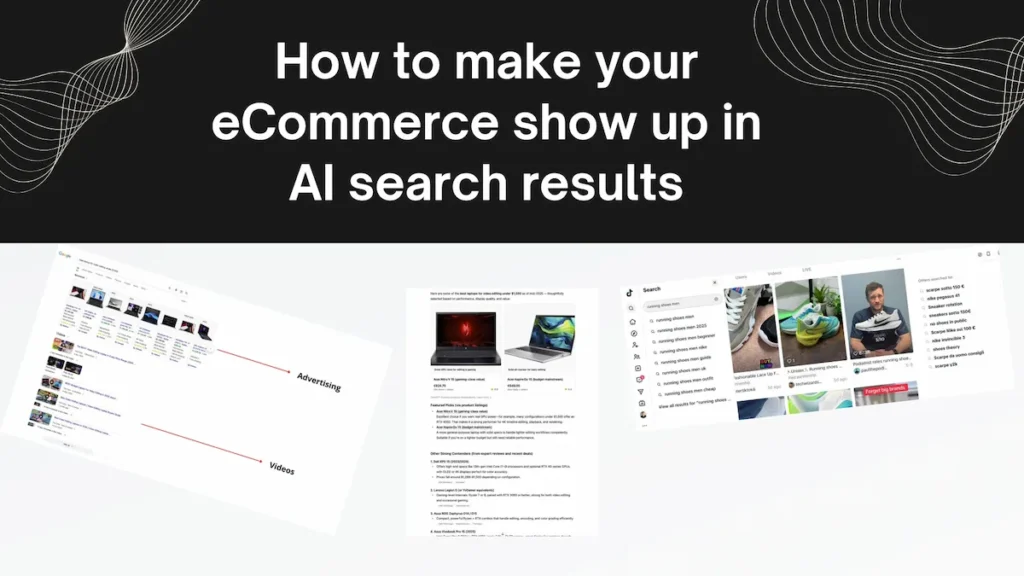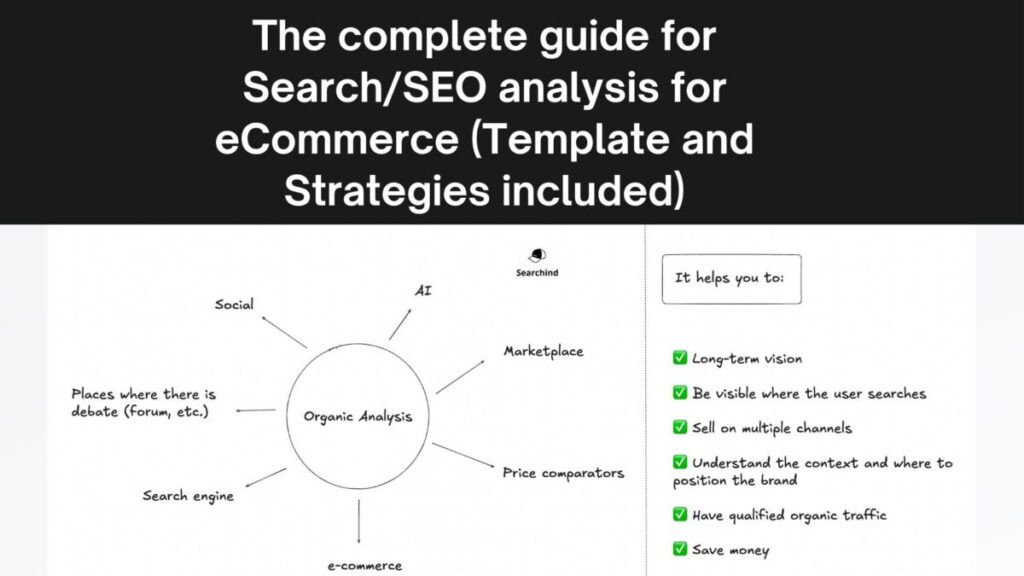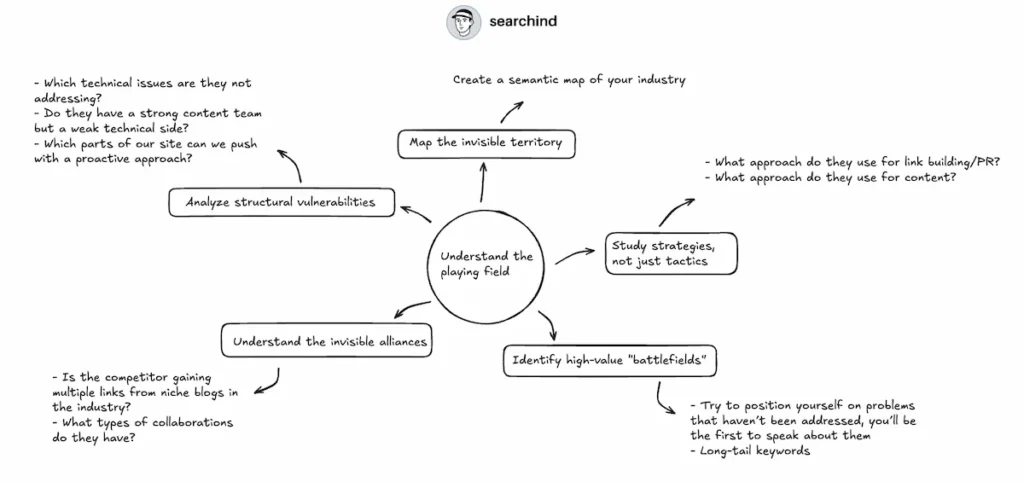If you want a quick tip to rank eCommerce in AI, this is not your article…
Appearing in an AI search without SEO basics is not possible.
If you want to grow exponentially with your eCommerce for many years and dominate your market, this article is for you.
If you want to build a solid brand, you need patience and consistency.
In this article, I’ll show you what you need to appear in AI search and build a solid SEO strategy for eCommerce with:
- Content
- Link building
- Technical SEO
- On-page
Many of the basics and techniques that I’ll show you are underestimated, but they generate revenue and qualified organic traffic for clients I have worked with.
Key changes in how search works
For search now I mean: social, forums, search engines, marketplaces, etc.
Don’t focus only on Google on AI; outside, there are many opportunities.
We can see an example of how search works.
Search in Google “best laptop for video editing under $1500” and see:
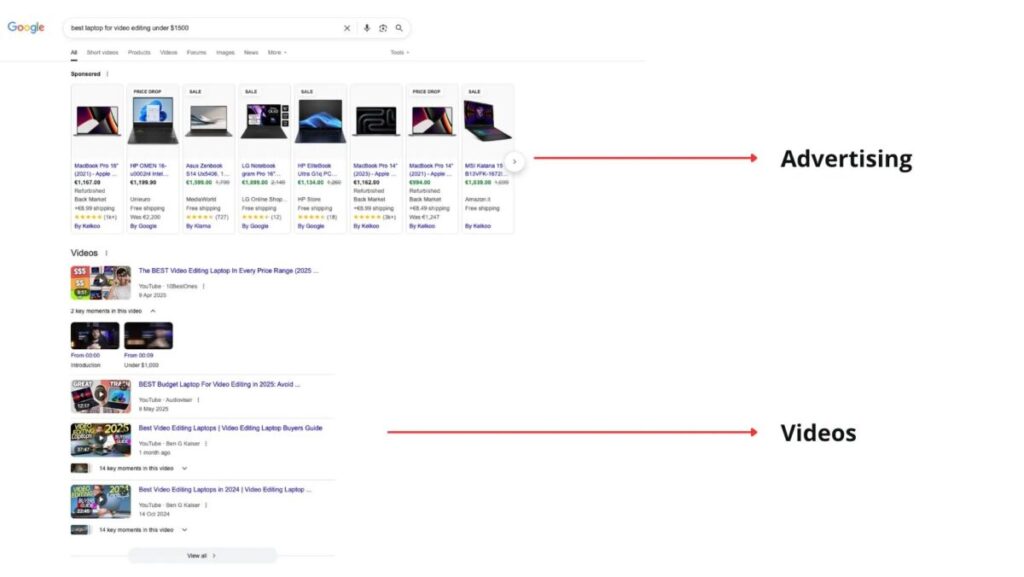
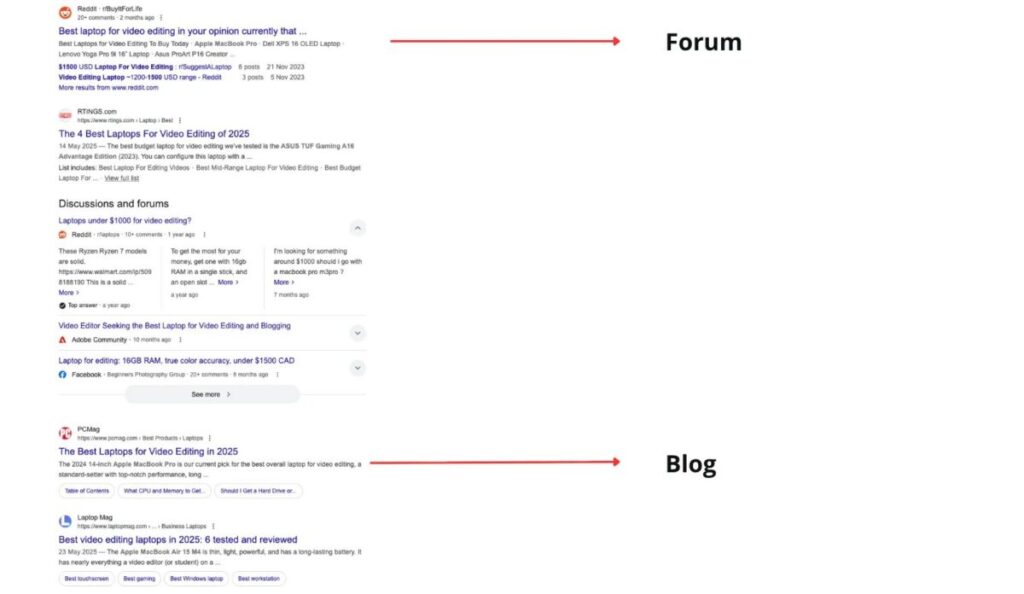
If you search in ChatGPT:
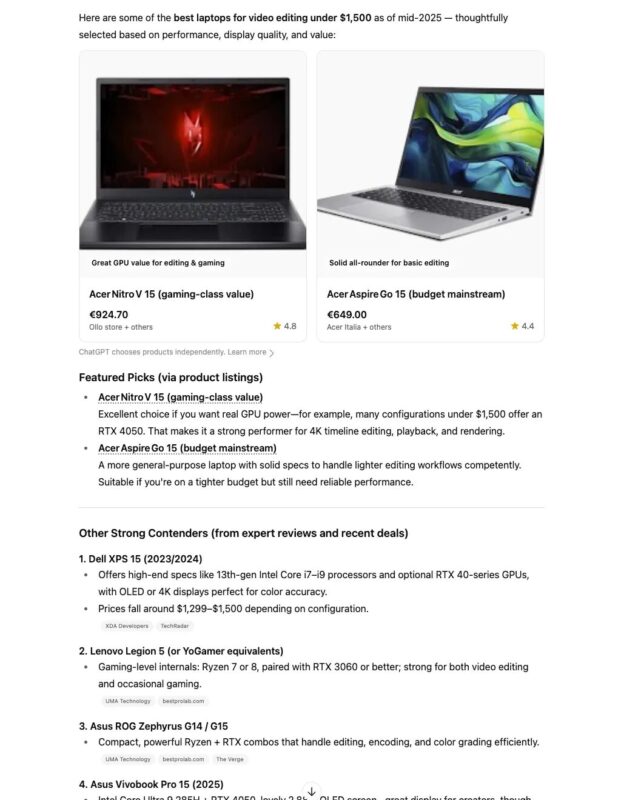
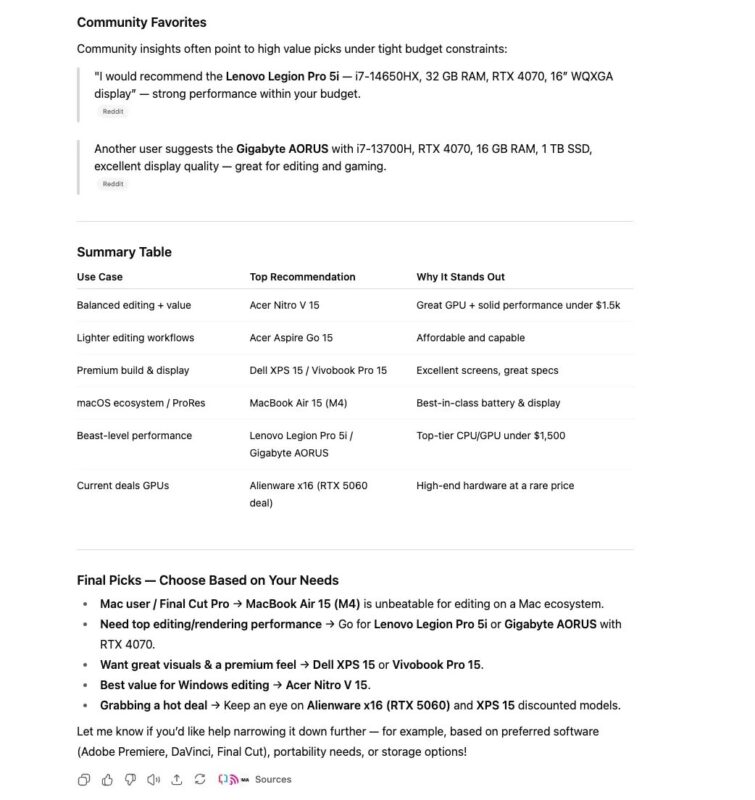
The big difference here is that ChatGPT summarizes the SERPs and gives you a “precise” response.
People who search in this way probably don’t buy through ChatGPT, but it is a phase in the customer journey of potential clients.
Another example of the customer journey is in Google results, where there are videos, forums, and blogs that can steal your client/audience.
For these reasons, it is important to have an SEO foundation to appear in this phase, resulting in a trustworthy eCommerce.
The entire search landscape has changed.
For example, now there are TikTok shops and Instagram shops, and many Gen Z users shop there. You can also put products in marketplaces, gaining internal marketplace traffic.
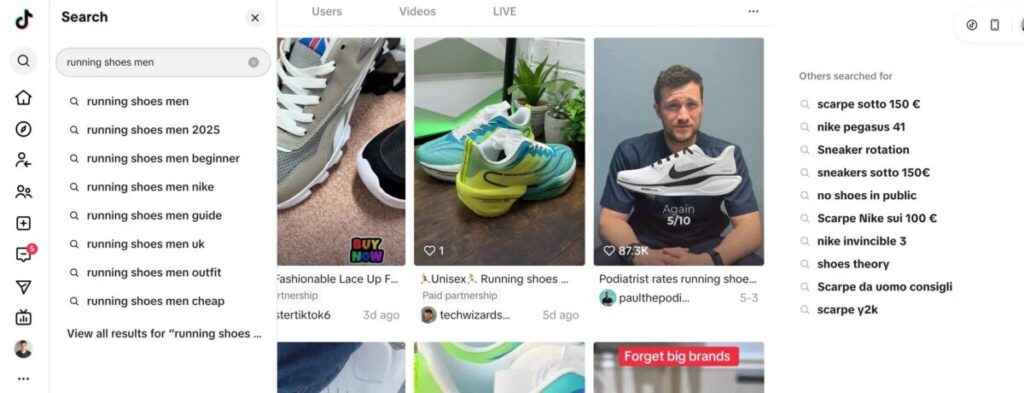
I worked with this marketplace, Nowarc.com, and we discovered that Pinterest was a goldmine.
We implemented a solid SEO strategy, and Pinterest gave us very good results (Conversion Rate) for our eCommerce.
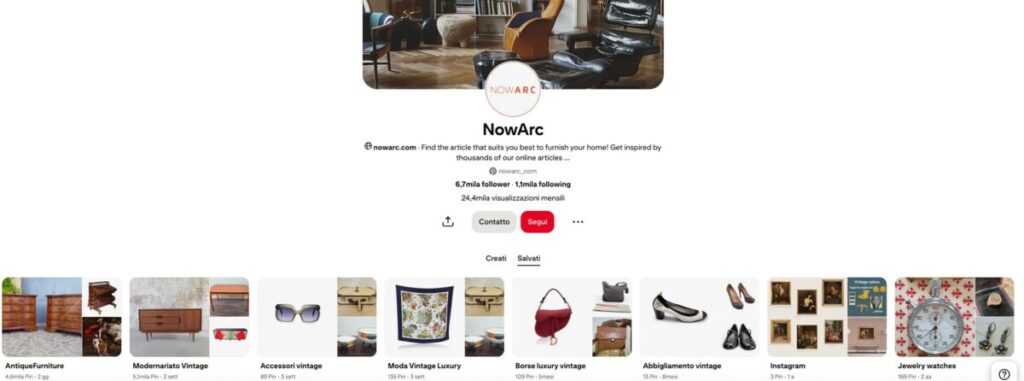
This is an example of how to gain an advantage from the entire search.
eCommerce content
AI prioritizes content that is accurate, detailed, and provides valuable insights.
Demonstrate expertise and trustworthiness through research, citations, and expert quotes.
Create user-focused content, address user intent, and provide clear, concise answers to their questions.
When I worked in a pet market, I saw a good e-commerce site, which is Zooplus.
Now, we’ll see different examples that help you implement the content basics of e-commerce that work.
Which content do you create:
- Informational content → Blog posts, guides, FAQs, and resource pages that answer general questions your audience has. Helps capture top-of-funnel traffic.
- Product content → Show the products with images, text, and videos.
- Comparison content → Build comparison pages between your products and competitors. AI tools often pull from these when users ask “X vs Y” questions.
- Use case content → Create content around specific problems your products solve, not just product features. AI tools excel at matching solutions to problems.
- Category content → Add optimized descriptions, buying guides, and FAQs to category and collection pages to rank for broader keywords.
- Educational / How-to content → Tutorials, step-by-step guides, and usage tips that show how to get the most out of your products.
- Social proof content → Reviews, testimonials, UGC (user-generated content), and case studies to build trust and reduce friction.
- Evergreen content → Long-lasting guides or resources (e.g., “The Complete Guide to Choosing the Right Running Shoes”) that keep bringing traffic over time.
- Trend & seasonal content → Blog posts, landing pages, and campaigns aligned with holidays, events, or seasonal needs (e.g., “Best gifts for Father’s Day”).
- Brand story content → About us page, sustainability practices, behind-the-scenes stories. Builds emotional connection and differentiates you.
- Support content → Returns policy, shipping info, warranties, troubleshooting, sizing guides. Reduces customer uncertainty and support tickets.
- Community content → Forums, Q&A sections, or blog posts that involve your customers in discussions. Builds loyalty and repeat visits.
Example of content funnel:
Top of Funnel (Attract)
- Informational content → Blog posts, guides, FAQs that answer broad questions. Brings in people who don’t yet know your brand.
- Educational / How-to content → Tutorials, step-by-step guides, explainer videos. Builds authority and trust.
- Trend & seasonal content → Pages for holidays, events, or trending topics that capture timely searches.
Middle of Funnel (Consider)
- Comparison content → “X vs Y” pages, best-of lists, alternative pages. Helps when customers are evaluating options.
- Use case content → Problem-solution articles and pages showing how your product solves specific needs.
- Category content → Optimized category pages with buying guides and FAQs. Helps shoppers compare and narrow choices.
Bottom of Funnel (Convert)
- Product showcase content → Product pages with photos, videos, specs, FAQs, reviews. Shows exactly what the buyer gets.
- Social proof content → Reviews, testimonials, case studies, user-generated content to remove final doubts.
- Support content → Clear shipping info, returns policy, warranties, and size guides. Reduces friction before purchase.
Beyond the Funnel (Retention & Loyalty)
- Brand story content → About us, sustainability, behind-the-scenes. Strengthens emotional connection.
- Community content → Q&A sections, customer stories, loyalty programs, or forums. Encourages repeat business and advocacy.
Structure category blog
We are seeing general blog pages that contain categories and articles.
Categories like: dog, cat, small pets, etc. are good because users find what they need easily.
Create and subdivide your blog categories that could be helpful for the users and to push your sales.
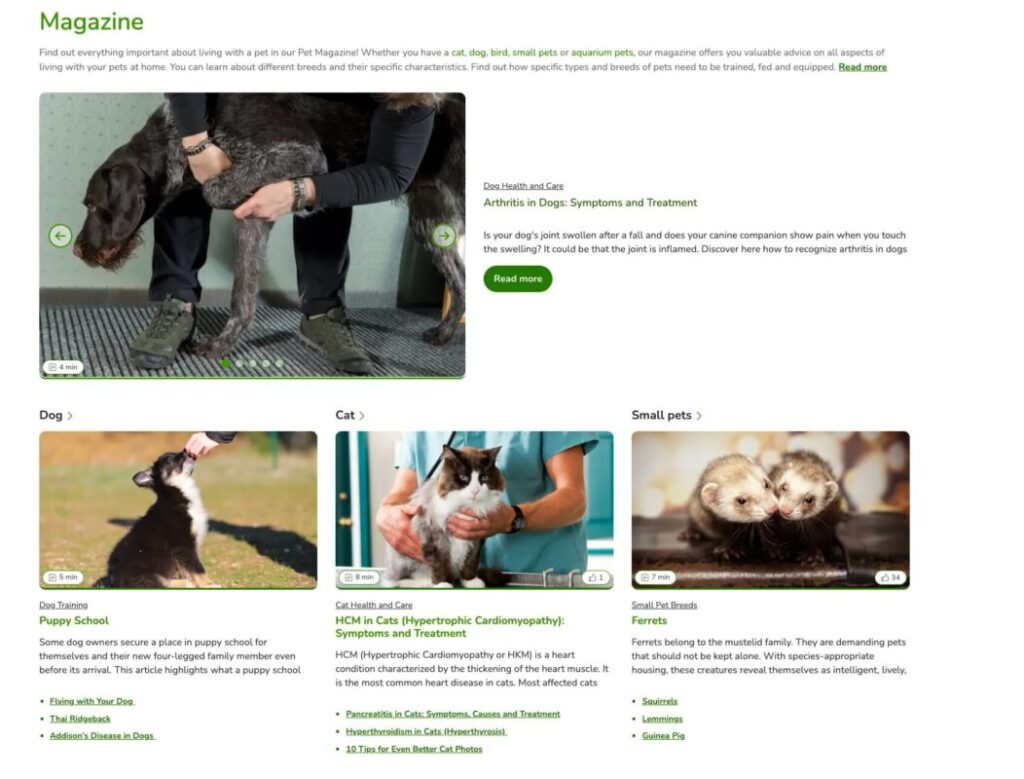
Most helpful articles
Always at home, it’s a useful link to different articles that are useful for SEO, business, products, etc.
Is a good link to the new articles because you’ll have fresh crawlability.
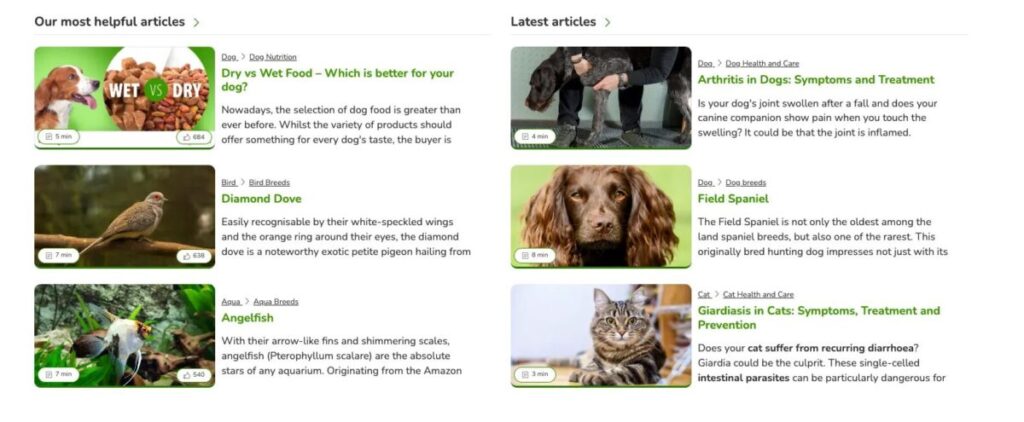
Single article
Now we see how to structure a single article.
In this article, there are many useful elements, like: time of reading, who wrote the article, last modified, short intro, and good title.
When a user enters the website for the first time, the first impression is MOST important.
Elements that are noticed are good to insert in your single article.
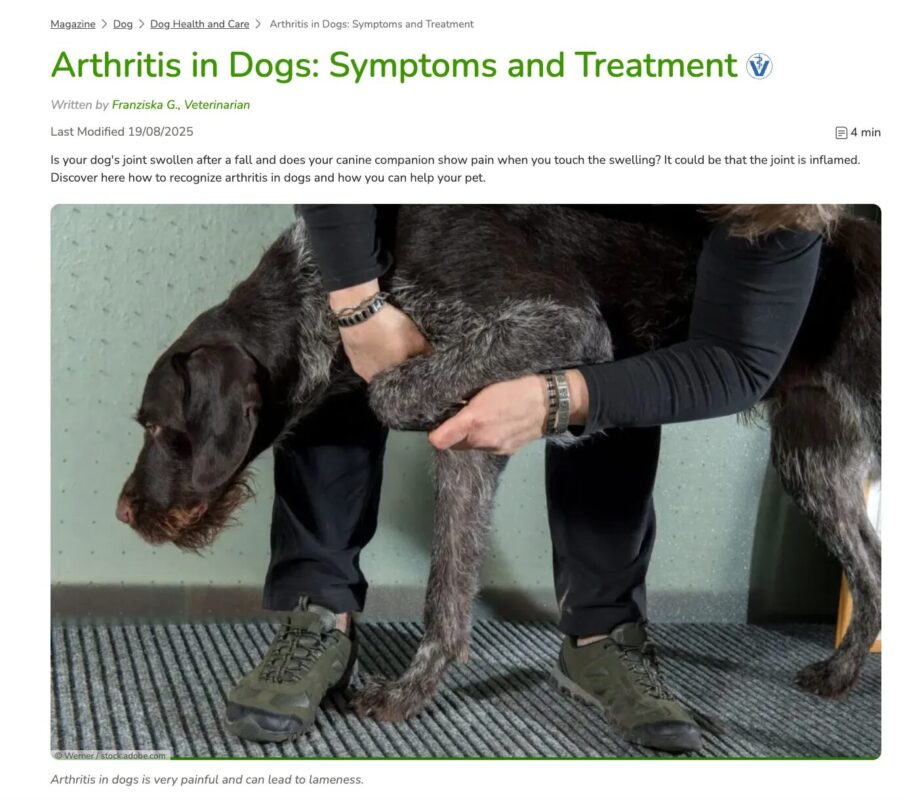
If I click → “Written by Franziska G., Veterinarian” pushes me below the article, giving the photos and the description about the author.
This is tremendously useful for obtaining authority and trustworthiness. In general, here is also better to put the social, site, etc. of the author.

Table of contents
If you scroll down, see the “table of contents”.
This is good because users can decide to skip a particular part or choose whatever, but it is also useful for SEO.
Here, you have many SEO plugins to use for this.

Quality of photos
Zooplus probably uses real images; it’s better for Google and AI because it differentiates from competitors that buy stock photos.
Here it’s important to describe the image very well, how Zooplus did it, and in ALT for seo.
Use a tool like Sqoosh to optimize the images.
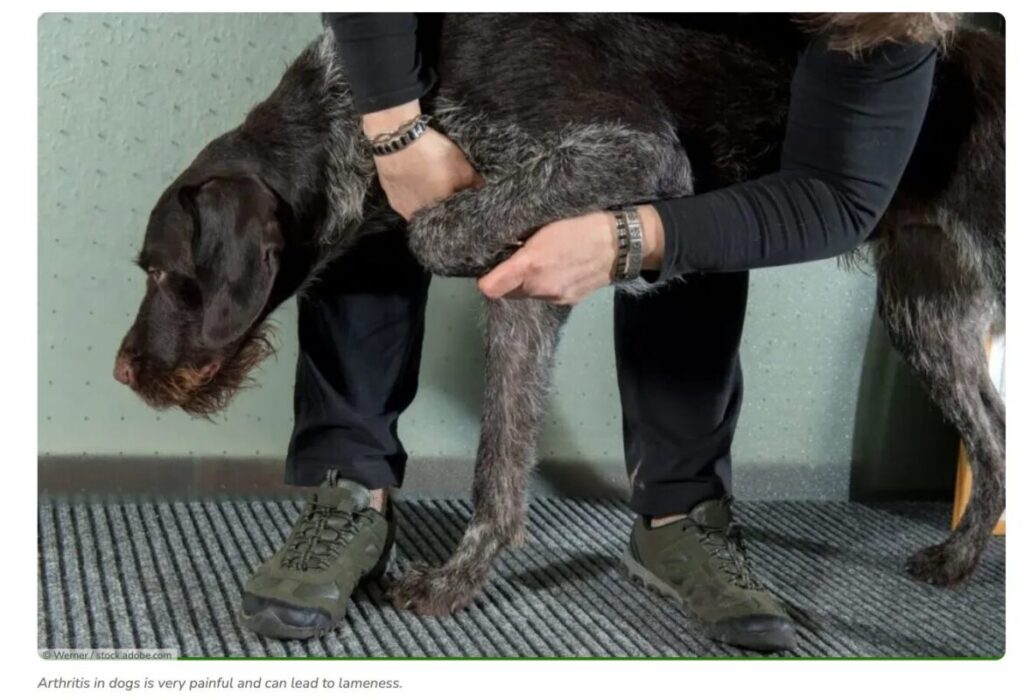
Related articles
Make this help users to orient better without leaving your site to read an informational article online.
The position is indifferent, try and test different options.


Related products and carousel of products
Zooplus has two different parts of the products.
In the first part, show “related products” and in the second, show other products related to the section.
This permits selling and has good crawlability from search engines.
Products that you link should correlate with the article and sections.
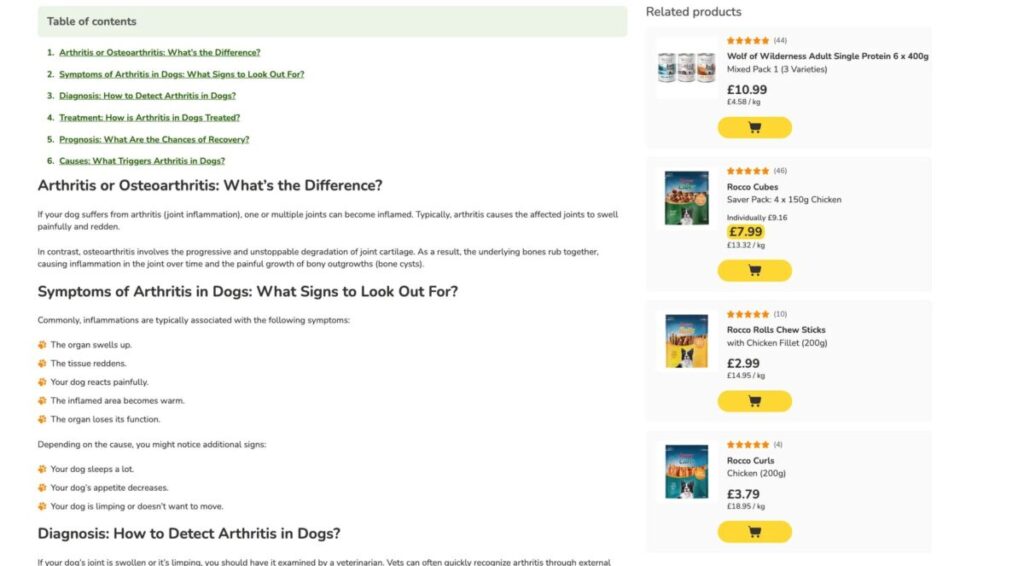
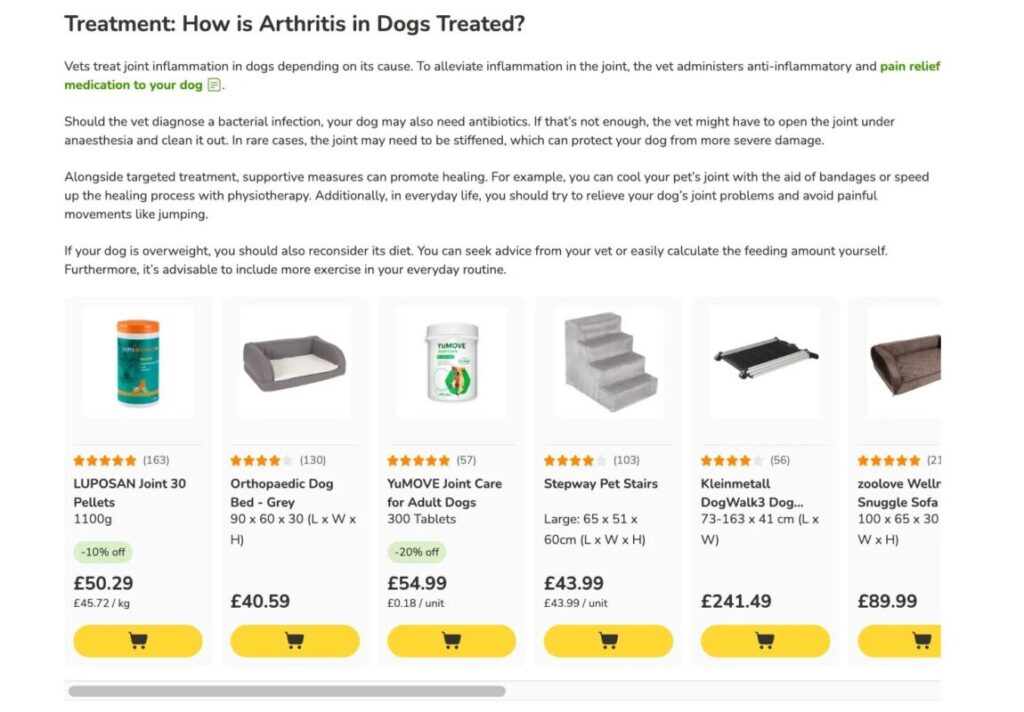
Emoij
Using emojis in the content, in this case, is better than using the classic bullet points; they personalize the content.
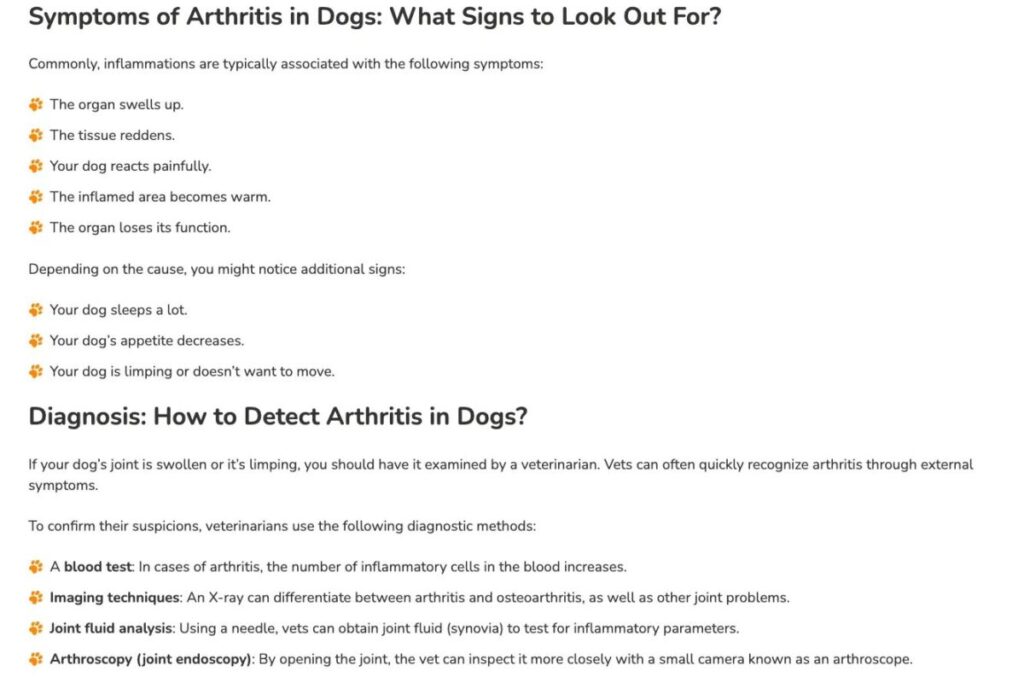
Content is not only in the blog or Google
If you want to appear in AI and different stages of searches for users, you need to stay in the right channels.
For example, Zooplus creates good content on YouTube. This content can also be distributed in the blog and vice versa.

When I worked in NowArc (marketplace), we obtained a high conversion rate from Pinterest, improving organic traffic and sell.
We published every day, each product that we had in NowArc, and optimised the SEO structure on this social.
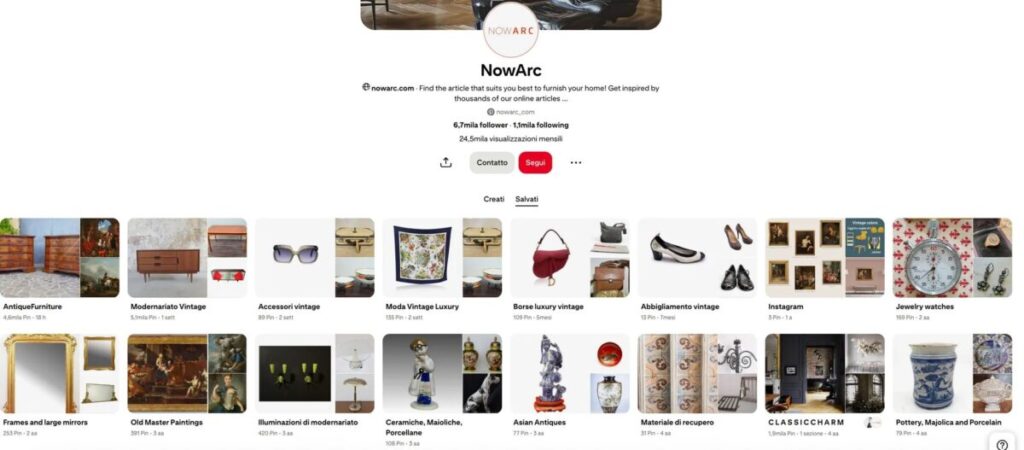
It’s also important to study and have a presence on forums like Reddit.
It’s tremendously useful because:
- You can estimate demand and spot trends.
- You get ready-to-use topics for your content plan or product optimization.
- You find real user questions to add to category pages.
- You can build a solid content plan for your blog and social media by addressing specific user needs.
- You give users a better brand experience, growing your authority while linking relevant resources back to your site.
- You can build a good product or resource that people are searching for but competitors don’t have.
I’ve used Reddit for a long time because Google alone doesn’t always provide the full picture.
And the same principle applies to clients: users often turn to forums like Reddit because many resources out there aren’t truly useful.
That’s why it’s important to analyze this platform and be present there.
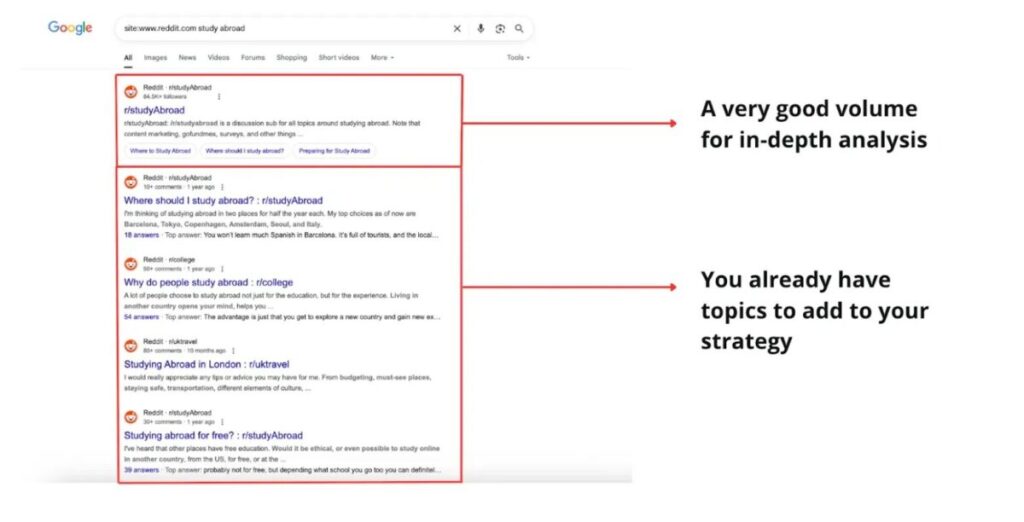
So, in conclusion:
Start with one channel, and try to obtain good results, then start in a granular way with other channels.
+50 Strategies and techniques help us to grow strong results for many businesses online, now it is FREE for you
Searchind Newsletter helps you to bring results in the business online, especially for ecommerce and DTC brands, with SEO and content.
Here, don’t share the news or things that you can find in many newsletters.
We cover SEO and Content Marketing differently with a business approach.
Have good management of the team and work
Good content requires good management. In every team that I’ve worked with, I saw many complex structures before publishing the content.
With a recent client, we had 10 people who: edit content, publish, review, write, etc. We reduced it to only 3 people. Many teams complicate the entire process.
For good management, you need to:
- Have a short list of roles for people
- Establish a channel/site for communication, for example:
- Google Drive → Write, comment, and review the content.
- Slack → Communication.
- A simple content calendar for managing all.

Create a dedicated FAQ page for your store
Step 1 → Talk to your support, sales teams and do an SEO analysis.
Collect the top 10-20 questions customers ask, shipping, returns, product availability, reviews, etc.
Do an SEO analysis to capture the possible volume, or use a tool like People Also Ask.
Step 2 → Build a single FAQ page that answers them all.
Why it works:
- If customers are asking your team, they’re also Googling it.
- Each FAQ becomes a chance to capture organic traffic.
- You reduce support tickets while improving trust and conversions.
One page. Endless upside.
👉 Pro tip: Structure each question as an H2/H3 so it’s crawlable and can win rich snippets.
Other tips
- Clear headings and subheadings: Help AI understand the structure and organization of your content. Create a logical structure with H2, H3, H4, etc., putting the HTML5.
- Short paragraphs: Make content easier to read and digest for both humans and AI.
- Use of bullet points and lists: Present information in a concise and organized manner.
- Demonstrate expertise and trustworthiness through research, citations, and expert quotes. If possible, try to write the expert in your topic in your blog, don’t write with AI (use it for improve the content).
- Learn and testing how to distribute content is essential to stay in the mind of your client.
Link building
Tactics that work:
Here’s a comprehensive list of link-building strategies you can adopt for your ecommerce business:
Content & Data-Driven Strategies:
- Create data-driven reports and infographics based on your customer data or industry insights that other sites will want to reference and link to.
- Develop comprehensive buyer’s guides, how-to articles, and educational content in your niche that become go-to resources.
- Publish trend analyses and industry reports that media outlets and bloggers will cite.
- Build detailed product comparison guides and educational content that naturally attracts links.
- Write guest posts for authoritative websites in your industry with keyword-rich anchor text linking back to your site.
- Create comprehensive FAQ pages that can attract users with commercial intent and earn links from informational articles.
User-Generated Content & Reviews:
- Encourage customer reviews and testimonials that can be referenced and linked to by other sites.
- Leverage user-generated content from customers showcasing your products on their own platforms.
- Partner with influencers for product reviews to gain brand awareness and potential backlinks (though primarily for brand visibility).
Partnership & Relationship Building:
- Partner with affiliates and bloggers in your industry, encouraging them to create content linking to your product categories.
- Collaborate with other businesses for strategic partnerships that provide mutual link benefits and put your brand in front of relevant audiences.
- Build relationships with industry publications and offer expert commentary or guest content.
PR & Media Outreach:
- Issue press releases for new product launches, partnerships, or exclusive collaborations.
- Use HARO (Help A Reporter Out) to connect with journalists and potentially earn backlinks through expert commentary.
- Create creative campaigns with interactive assets, graphics, or extensive blog posts that naturally attract backlinks.
- Implement reactive link building by capitalizing on trending news or keywords relevant to your industry.
Social & Local Strategies:
- Build social media presence across platforms (YouTube, Twitter, Facebook, Pinterest, Instagram, TikTok) to gain brand awareness and cross-platform visibility.
- Utilize Google Business Profile posts to promote deals, news, and announcements for local SEO benefits and potential traffic generation.
- Create location-specific content to attract local backlinks from regional media and bloggers.
Other:
- Use the Skyscraper technique by finding high-value competitor links, creating better content, and getting publishers to replace competitor links with yours.
- Implement broken link building by finding broken links on relevant sites and offering your content as a replacement.
- Insert links into existing high-value content pieces through niche edits to gain quick links from established, indexed content.
- Create comprehensive manuals and support sections that can earn links from informational articles, thereby enhancing the customer experience.
- Build a presence on different forums like Reddit.
Content ideas for link building
Creating valuable content that naturally attracts backlinks is essential for ecommerce success.
Here are nine proven content types that drive both customer engagement and quality backlinks:
01. Comprehensive Product Guides
Create in-depth resources covering every aspect of your product category.
A thorough guide like “The Complete Guide to Choosing Kitchen Knives” naturally attracts links from cooking blogs, culinary forums, and recipe sites.
These evergreen guides demonstrate expertise while helping customers make informed purchasing decisions.
02. How-to Videos and Tutorials
Video content allows you to demonstrate products in action while answering common customer questions.
These tutorials often get shared across platforms and drive backlinks to your site.
The visual format is particularly powerful.
03. Customer Success Stories
Authentic stories about real customers solving problems with your products build trust better than sales pitches.
These human-centered narratives resonate with potential buyers and encourage bloggers to link when highlighting genuine customer experiences.
04. Seasonal Buying Guides
Time-sensitive content like “Essential Back-to-School Tech Gadgets” or “Winter Home Comfort Must-Haves” captures seasonal traffic and attracts links from holiday roundups and shopping lists.
This content reliably surges each year during relevant seasons.
05. Product Comparison Charts
Side-by-side analyses help customers make quick, informed decisions while saving them research time.
These factual comparisons frequently earn links from review sites, blogs, and news outlets seeking reliable product information.
06. Infographics
Visual content presenting data and complex ideas in digestible formats has high shareability potential.
Well-designed infographics on topics like “The Rise of Sustainable Shopping” attract attention from industry blogs and social media, earning valuable backlinks.
07. Industry Trend Reports
Publishing data-driven analysis and predictions establishes thought leadership in your niche.
Reports like “E-commerce Technology Trends Reshaping Retail in 2025” provide value to journalists, bloggers, and businesses, driving both credibility and backlinks.
08. Behind-the-Scenes Content
Transparency about your operations humanizes your brand and builds stronger customer connections.
Content showcasing fair-trade sourcing practices can attract links from ethical business websites while building trust.
09. User-Generated Content
Encouraging customers to share photos, reviews, or videos creates fresh content and authentic social proof.
Photo contests and customer showcases can go viral, generating backlinks from participants while adding credibility to your brand.
These content strategies work because they provide genuine value to your audience while naturally encouraging other websites to reference and link to your resources.
How to start a link-building campaign
- Analyze your colleagues’ link-building approach (if any has been done).
Get a sense of the approach they’ve adopted.
- Study your competitors’ approach
- Performance Analysis: In the first months, did they acquire X links and achieve X results or face X potential penalties? etc.
- Target Selection: Do they focus on micro-niche sites, target sites with high Domain Authority (DA), etc.?
- Anchor Text Strategy: Do they focus on brand anchors? Exact match anchors? Synonym anchors? Or do they have a balanced approach across all these anchor types?
There’s no right or wrong way; in one sector, we worked exclusively with exact match anchors, in others, we used only mixed approaches, etc.
This area requires a lot of testing and strategic vision.
- Content Strategy: Do they have blog articles that they’ve built links to?
- Popular Content Analysis: Check competitors’ most linked pages and see if they’ve leveraged (for example) articles with infographics or content that appeals to journalists.
These should be an integral part of the strategy because you get “free” links.
This second part is essential for differentiation.
People often think copying is the right choice, but you can’t follow many competitors due to budget constraints, and you might invest better than they do.
If they’re moving slowly in some areas, you could push toward zones that might require more proactivity and a lower budget.
For example, if they haven’t done link building on niche blogs that have low DA but loyal users (who might even buy products the blog promotes, etc.), this is excellent compared to a blog with 3,000 guest posts or similar.
For all these activities, I use Excel; it’s very easy to make comparisons with competitor sites, etc.
- If you’re unsure about what you’re doing, pay for a consultation
Even now, when I want an opinion and analysis from someone who knows more than I, I pay for consultation or rely on partners.
If you need it, book a call with me.
Try this easy method
Write in Google ‘guest post’ (keyword/market), in this case is pets.
Or write ‘write for us’ (keyword/market) in this case, pets.
It’s manual work, yes.
You can automate this.
In this method, you can find new contacts to build a strong relationship.

Stop wasting your budget.
Let’s get brutally honest about link building.
For anyone who isn’t a mega-brand or doesn’t have an army of PR professionals, your “link-building strategy” is nothing short of a SCAM.
You’re throwing money down a black hole, chasing low-quality backlinks, or worse, engaging in desperate outreach that makes your brand look pathetic.
The idea that you can consistently acquire high-authority, relevant backlinks through manual outreach, without being an established powerhouse, is a fantasy.
Google prioritizes actual brand authority and natural citations.
Your “strategy” of buying links, swapping links, or begging for links is not only ineffective but also puts your domain at massive risk.
Wake up!
While mega-brands get links naturally because they are mega-brands, your business needs to focus on creating content so damn good, so uniquely valuable, that people want to link to it.
So, in general, it’s normal to acquire a link.
But you do consciously.
For example, if you are working on bio eCommerce, you target a blog/influencer specific to this area.
It’s better to have a link from Ansa, because specifying in this case could bring the client, and not only traffic.
Try to have a good balance of:
- The link that you acquire
- Mentions → Forum, social, etc.
- Collaboration with an influencer or similar
- Pages/content that you can attract a free link (guides, research, etc.)
Find the good balance and go ahead.
Technical SEO
The general problems:
- Canonical Management
- Tag & Filter Management
- Breadcrumb Management
- Noindex Management
- Multiple H1s Management
- Pagination Management
- Performance Management
- Sitemap Management
- Hreflang Management
- Structured Data Management
- International SEO
- Crawl management
- HTML Structure
For these, I have different automations and solutions to resolve.
We can see whatever.
International SEO
This topic is very complex.
Many eCommerce sites have international SEO problems. It is harmful because you lose revenue, and Google should be penalized.
Here, the solution is to set the hreflang attribute correctly in the code with the corresponding ISO code.
Below you can see a bad example.
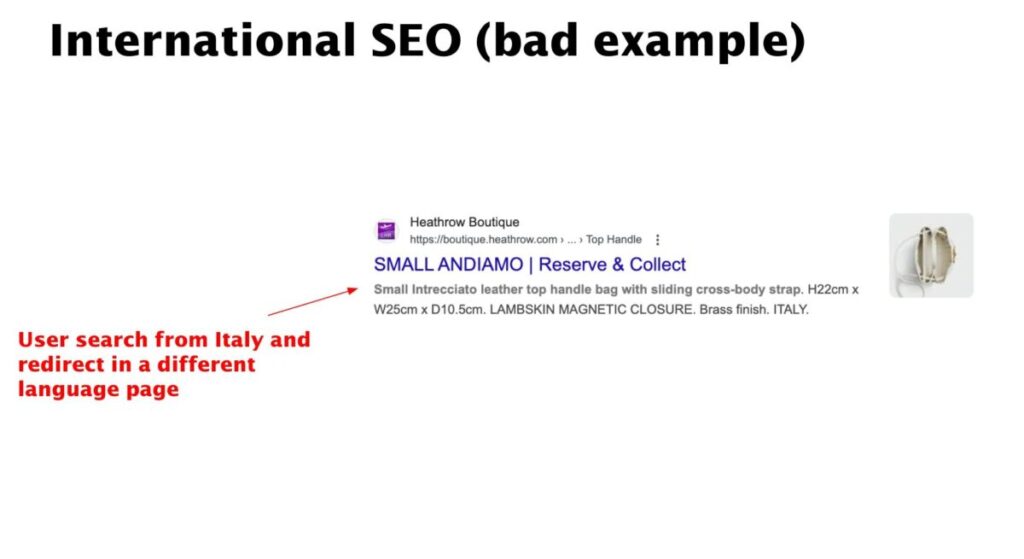
So, users who navigate the site don’t want to receive this page, and they’ll probably leave.
Breadcrumb
Breadcrumbs need to follow a logical path.
For example, in this brand category “Burberry”, we followed the path that was useful for Google and for the users.
Because “Burberry” is present in “Women’s brand” → “Brands”.

And if we continue in the product pages, the path is complete, and in the final, there is a SKU/Model because in this niche, it is useful for users and ranking.

Structured data
My personal advice is to be very precise here.
Study the market → Study the eCommerce that you work in → adapt structured data.
I don’t want to give you the general basics of structured data because each market has different needs.
Implementing this requires study and expertise, so if you don’t have expertise, you can contact me with a 1:1 call on this page.
Below, I’ll give you different examples of good structured data that I implemented for my client.
For products
For category
https://validator.schema.org/#url=https%3A%2F%2Fviettishop.com%2Fcollections%2Fganni%2Fwomen
For brand pages
https://validator.schema.org/#url=https%3A%2F%2Fviettishop.com%2Fpages%2Fbrands
For home
https://validator.schema.org/#url=https%3A%2F%2Fviettishop.com%2F
For the company
https://validator.schema.org/#url=https%3A%2F%2Fviettishop.com%2Fpages%2Fthe-company
Pagination
Many ecommerce sites prefer block pagination, but in different cases isn’t good because you can block the discoverability of products.
I prefer to put index, follow, and self-referential, below you can see what I said.

With this, my client, when I fixed this, enhanced our product discoverability, enhancing page product indexing.
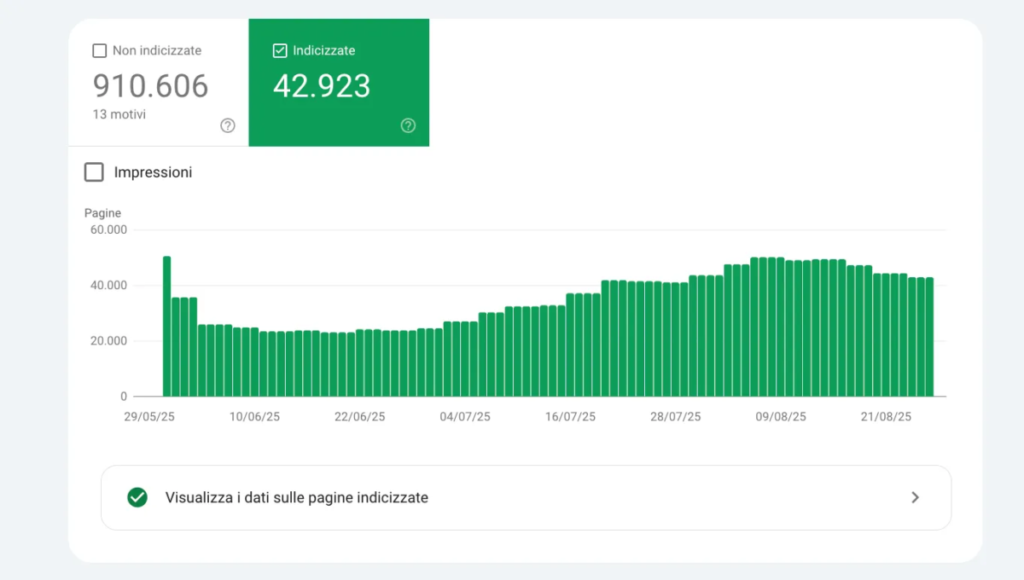
HTML Structure
Insert the right HTML structure to help search engines better understand your site. Many competitors neglected this, and my different clients have changed significantly in ranking.
We can see examples.
For this client, we cleaned the heading structure and now present this.
In fashion eCommerce, size and brand are important; in fact, we gave an important heading <h2>. But if you watch better, you can see different SEO tricks.

It is also good to organize in a clear way the size and color with the <ol> tag. This will help Google to better understand your page.
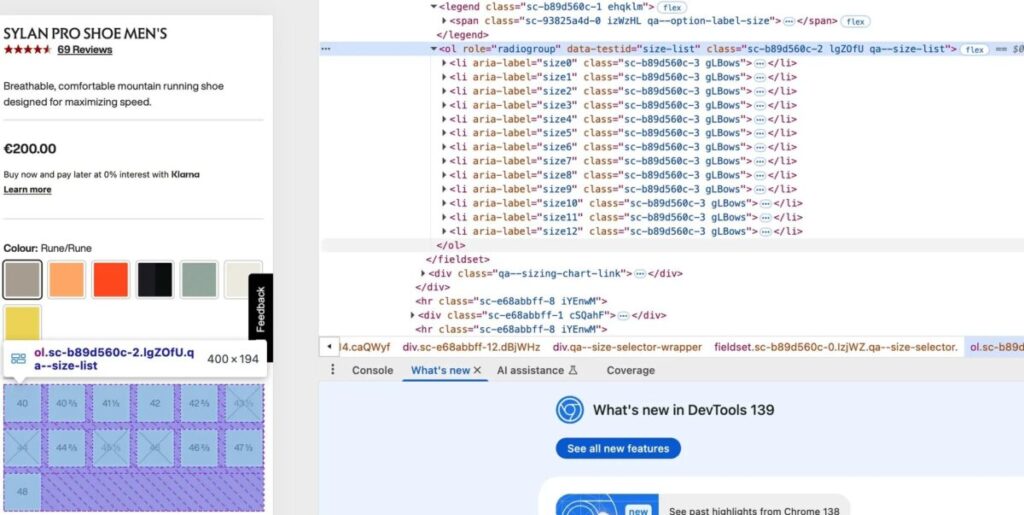
So, study HTML5 very well.
On-site
Category
Many eCommerce sites neglected these aspects.
Meta title, meta description, and H1, if optimised well, can gain you an easy win with low effort.
Here, need to study what works for the sector and then implement testing.
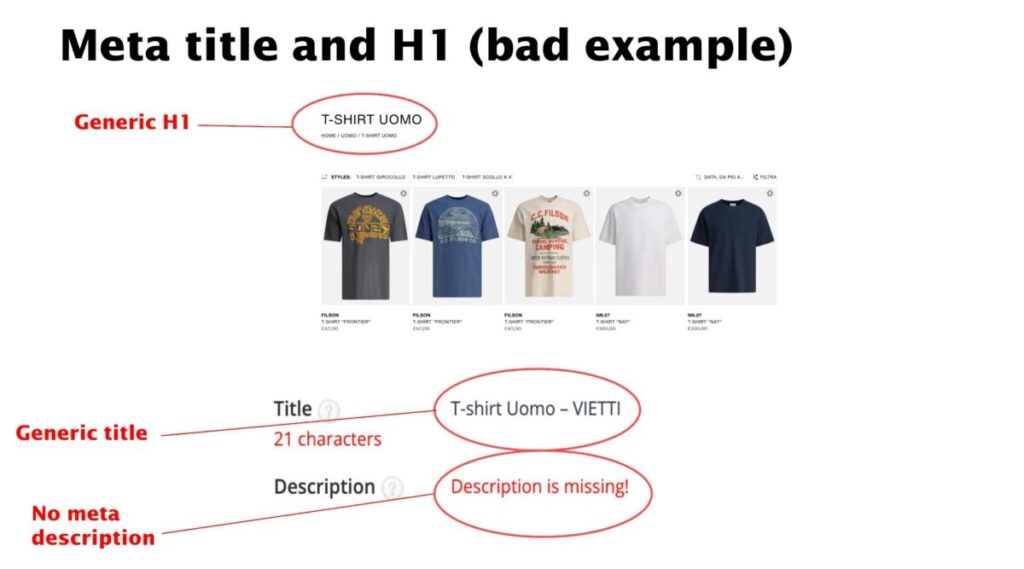
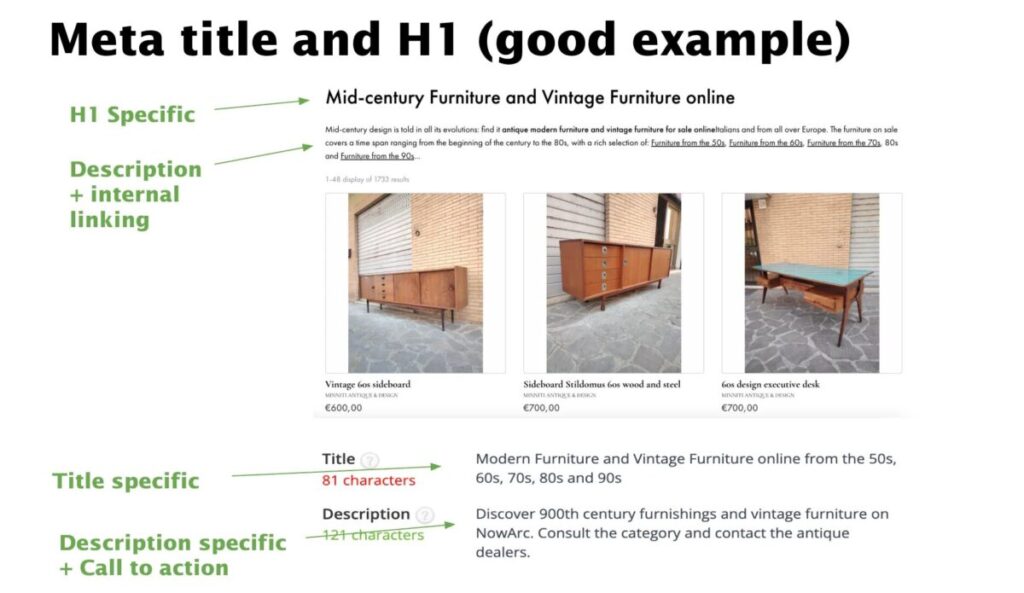
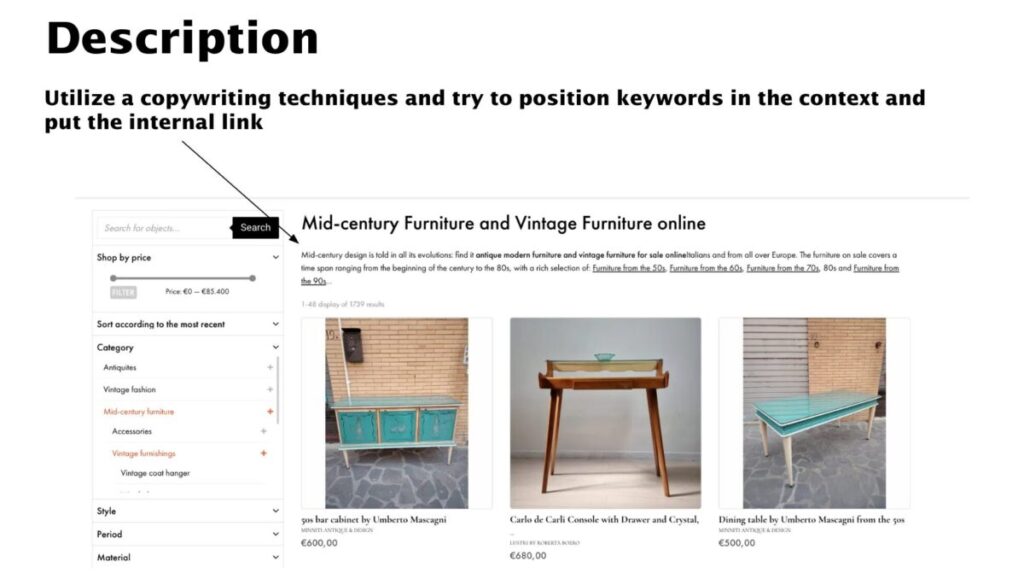
Brand category
Many eCommerce sites focus on well-known brands. But this is often not a smart move, because you end up competing with giants who have much bigger budgets than you.
This is especially true in the fashion industry. A better strategy is to:
- Start by analyzing and optimizing the pages of less distributed brands.
- Focus on keywords with low competition and lower search volume.
It’s a smarter entry point: less competition, quicker results, and a chance to build authority step by step.

Create a dedicated Reviews page
✅ Small brand? People Google you to check if you’re legit.
✅ Big brand? Thousands search for “[brand] reviews” every month.
❌ Don’t send them to Trustpilot.
❌ Don’t let shady review sites control the narrative.
✅ Take ownership:
- Create a dedicated page
- Add a short intro text
- Embed UGC, video reviews, testimonials, and more
Build a solid company page
Many eCommerce companies underestimate this, but it’s also important for new users who enter the eCommerce.
For example, Gucci has a good page → https://www.gucci.com/it/it/nst/history-of-gucci
Build a solid page that contains all the history that the company has, showing video, text, photo, and other information that is useful.
Product pages
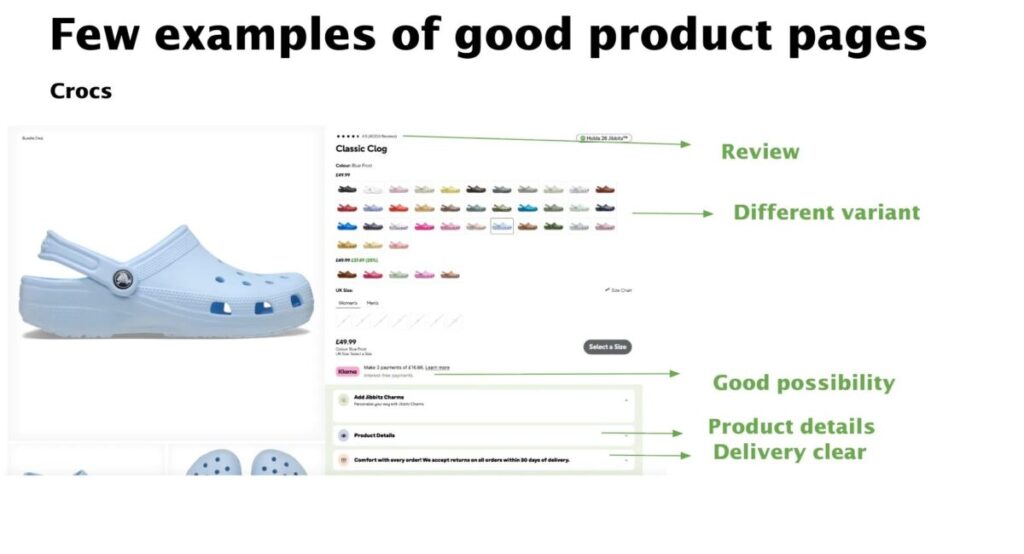
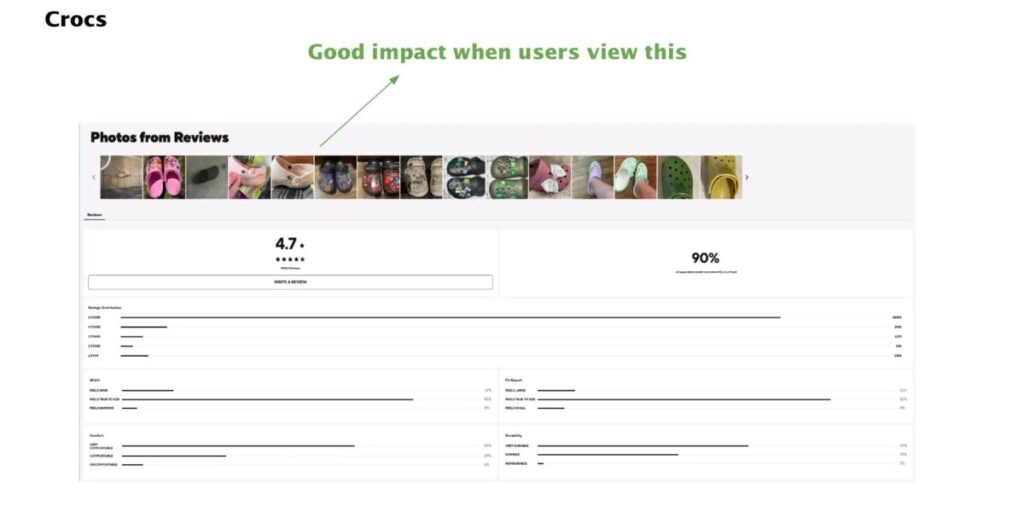
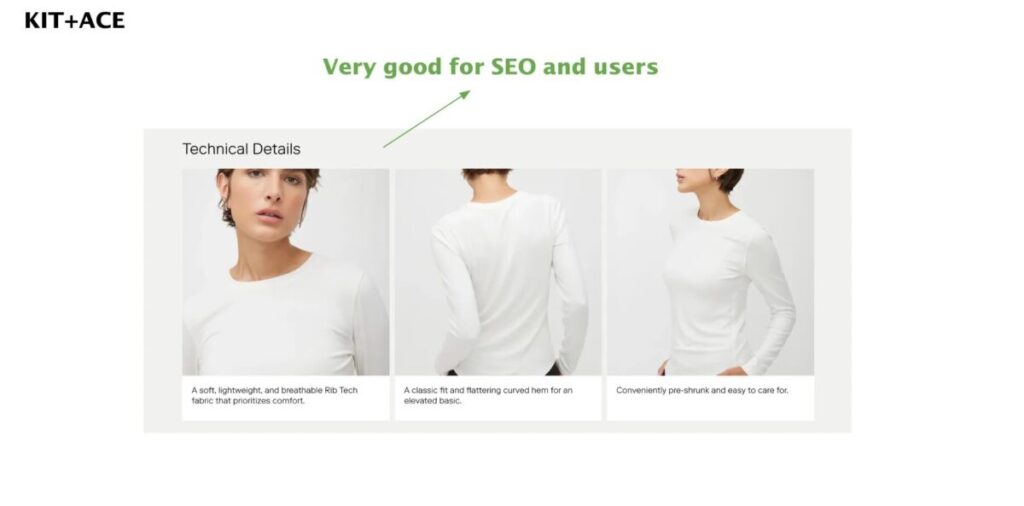
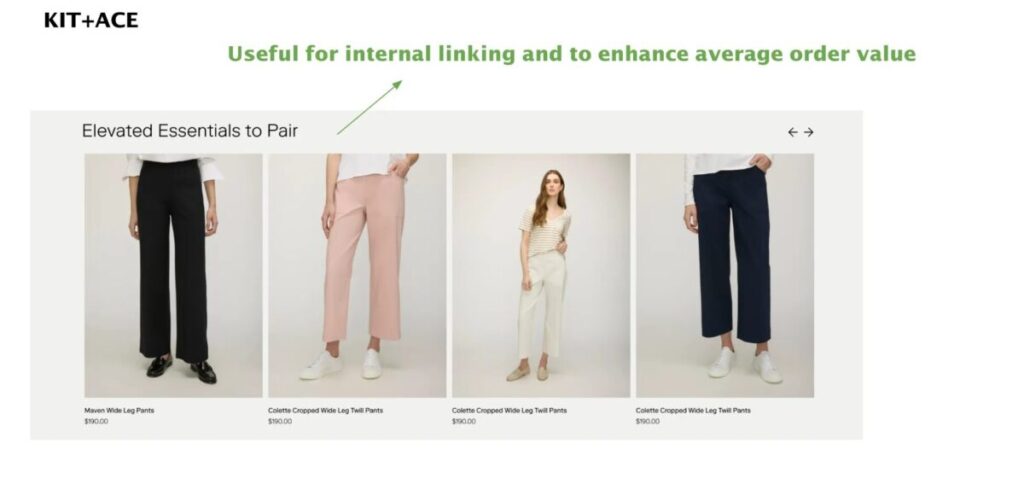
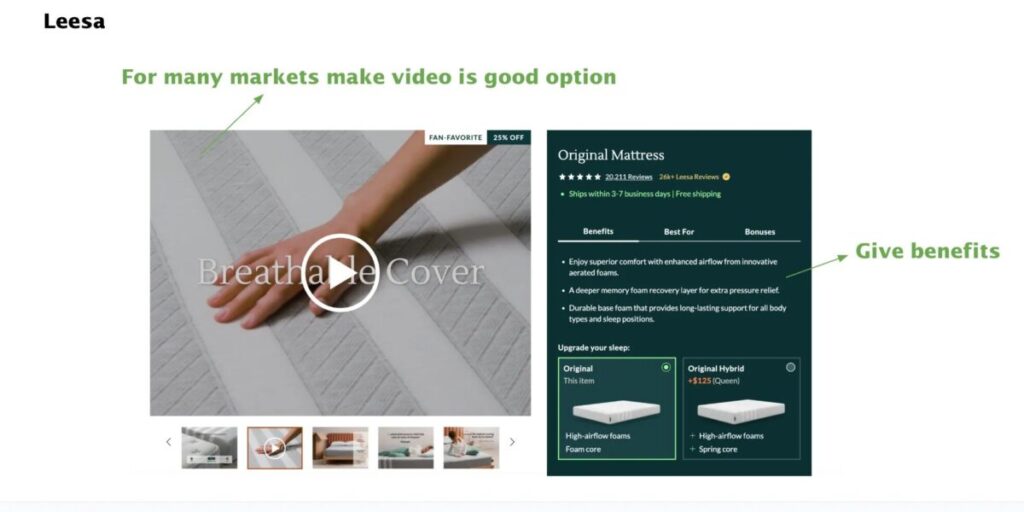
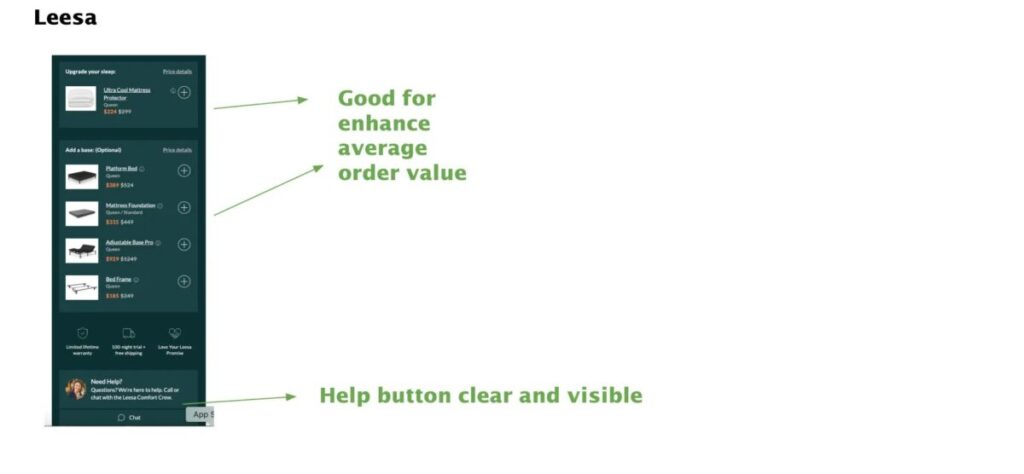
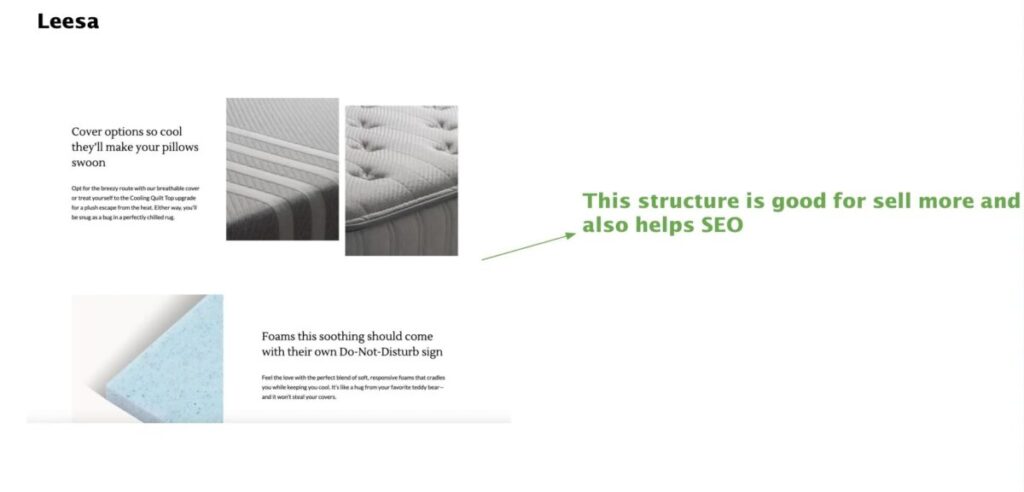
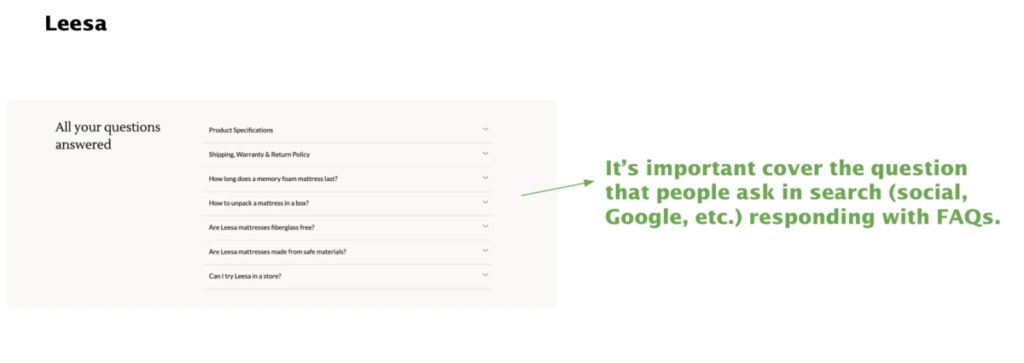
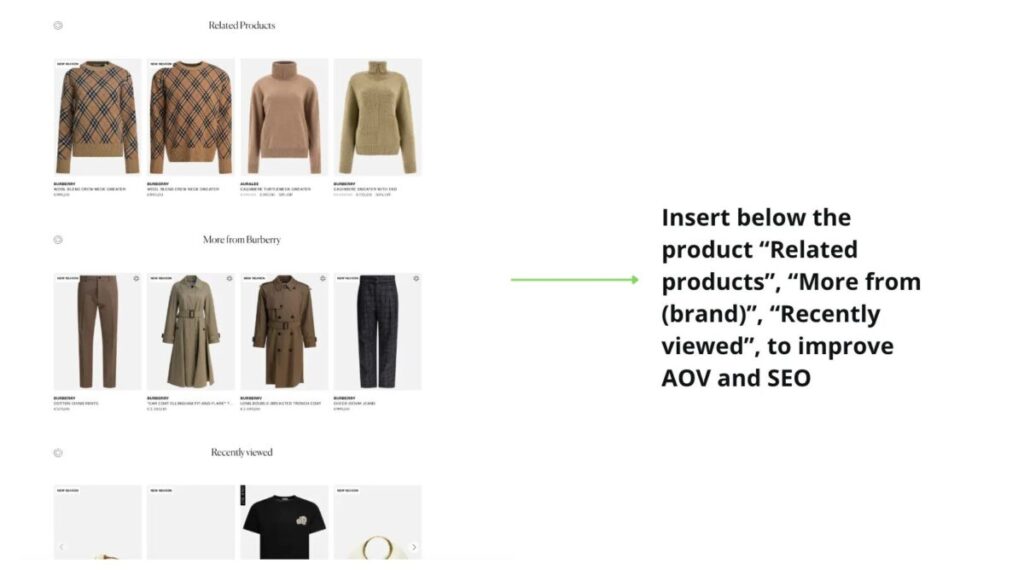
Many emerging ecommerce brands miss a crucial visibility opportunity: product feed distribution.
Without proper setup, your competitors’ items may appear when customers search for your brand across major platforms.
If you haven’t connected your product catalog to Google Merchant Center for Shopping tab visibility, you’re missing significant search traffic.
This foundational step prevents competitors from capturing searches related to your brand.
AI-powered search platforms are creating new discovery channels:
OpenAI’s beta program enables product visibility within ChatGPT conversations through submitted feeds. → https://openai.com/chatgpt/search-product-discovery
Early access applications are available at their product discovery portal.
Perplexity AI’s Merchant Program offers another emerging avenue for product exposure through their search interface. → https://perplexity.typeform.com/to/oIcfT8U3
And optimize very well → https://merchants.google.com/
With this client, we obtained a good result in Google Merchant in only 28 days. Here, I advise using Datafeedwatch or a similar site to automate the work.
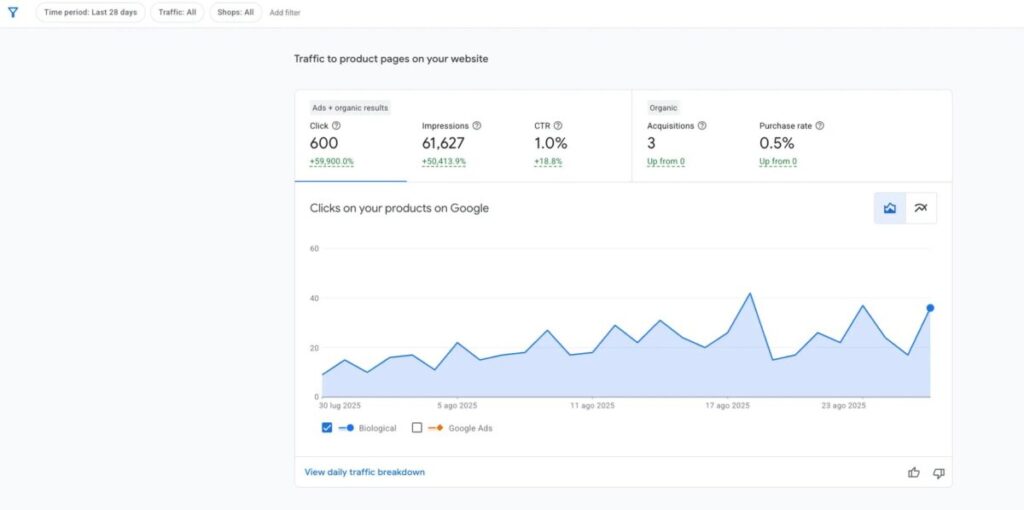
Most established ecommerce platforms already include automated feed generation, making setup straightforward with minimal technical requirements.
Early adoption of these AI-driven discovery channels positions your products where customers increasingly turn for purchase research, while competitors remain invisible in these growing search environments.
My conclusion
There doesn’t exist a quick trick to ranking in AI search.
It works very well with SEO, and then you appear in AI search.
Many professionals sell you the dream, but honestly, I prefer to share a good resource that is applicable now and is realistic.
As always, if you want to do good SEO and build a solid brand, you must do the basics well:
- Link building and PR
- On-site
- Content
- Technical SEO
If you work VERY WELL on these, you’ll achieve good results.
And you don’t think only in AI search, now is important to think of the entire organic: social, forum, marketplace, etc.
Work together?
Book a 1:1 meeting call below

